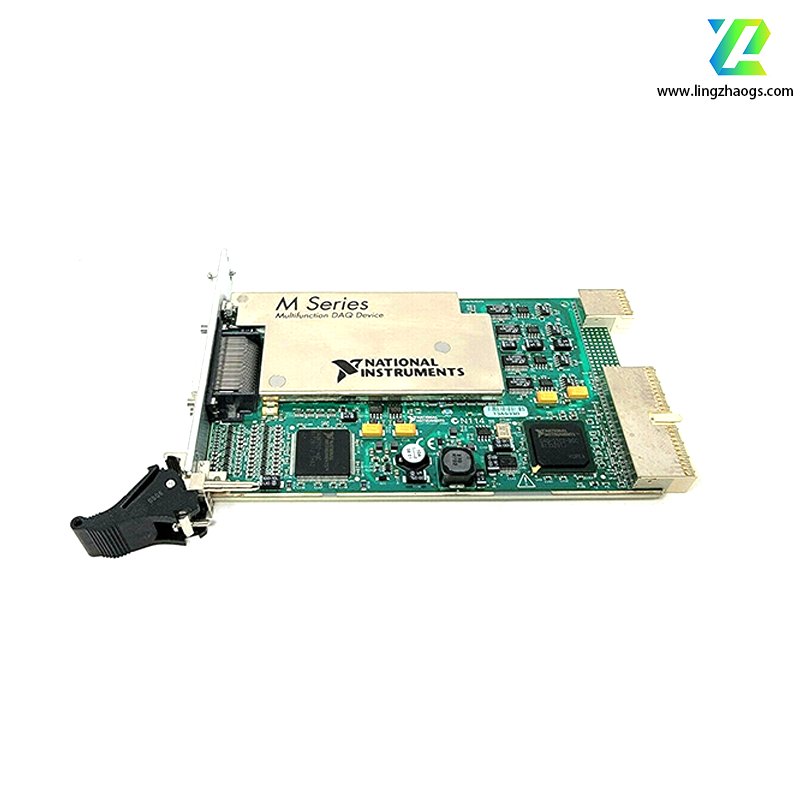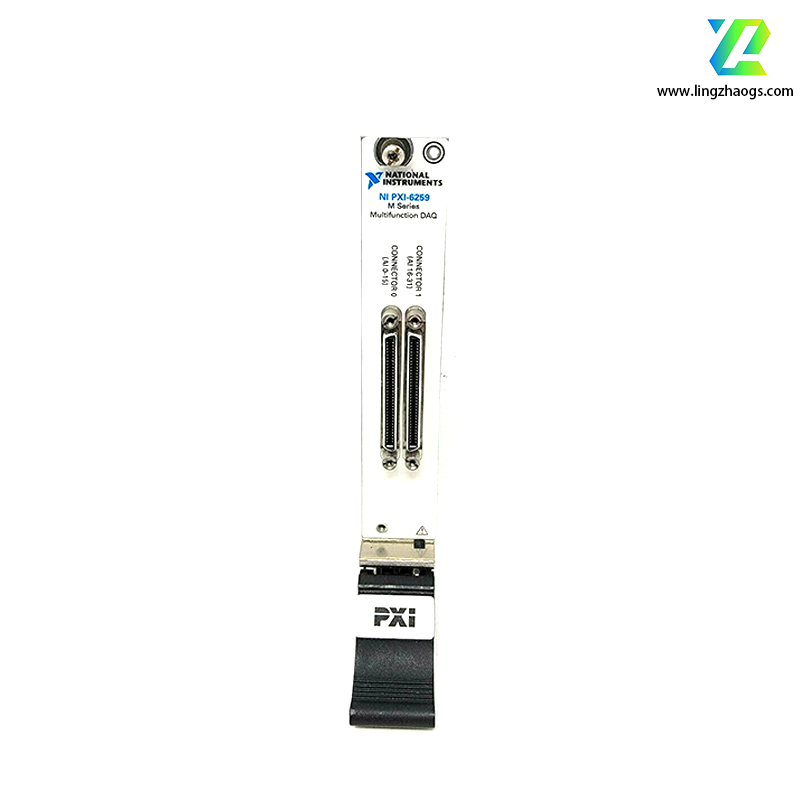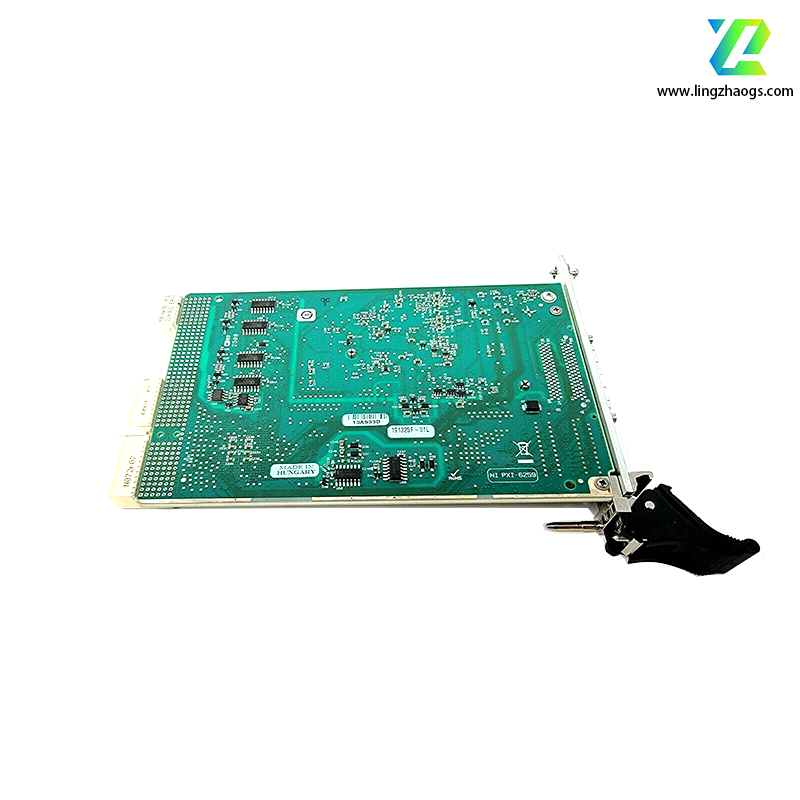Detailed Specifications of NI PXI-6259 Multifunction DAQ Module
The NI PXI-6259 is a high-performance multifunction data acquisition (DAQ) module in National Instruments (NI)’s M-Series, specifically designed for the PXI bus architecture. Integrating advanced analog input/output, flexible digital I/O, and high-precision timing functions, it is particularly suitable for complex measurement and control scenarios requiring multi-channel synchronous output, and is widely used in industrial automation, aerospace testing, scientific research experiments, and other fields.
1. Basic Information
- Module Series: M-Series multifunction DAQ module, optimized for PXI systems
- Part Number: 779075-01 (standard model)
- Physical Dimensions: 3U PXI standard size, 3.8 inches × 6.1 inches (approximately 9.65cm × 15.49cm)
- Weight: Approximately 5 ounces (0.14kg)
- Interface Type: 68-pin VHDCI (Very High-Density Cable Interconnect) interface, supporting compact and reliable signal connections
- Operating Temperature Range:
- Commercial grade: 0°C ~ 55°C
- Extended grade (optional): -40°C ~ 85°C (suitable for harsh industrial environments)
- Environmental Protection Ratings:
- Shock Resistance: 100g peak (duration of 11ms)
- Vibration Resistance: 5g RMS (frequency range 10Hz ~ 500Hz)
- Dust Protection: IP30 (prevents intrusion of solid foreign objects)
2. Core Technical Specifications
2.1 Analog Input
- 16 single-ended inputs / 8 differential inputs
- Supports three input modes: Referenced Single-Ended (RSE), Non-Referenced Single-Ended (NRSE), and Differential (DIFF), adapting to different sensor signal types
- Resolution: 16-bit ADC (Analog-to-Digital Converter), ensuring no missing codes (differential nonlinearity error ±0.5 LSB)
- Maximum single-channel rate: 1.25 MS/s (mega samples per second)
- Multi-channel aggregate rate: 1.0 MS/s (stable synchronous acquisition in multiplexing mode)
- Input Ranges: 7 switchable ranges to cover different signal amplitude requirements: ±0.1V, ±0.2V, ±0.5V, ±1V, ±2V, ±5V, ±10V
- When the module is powered on: ±25V
- When the module is powered off: ±15V
- Maximum input current per channel: ±20mA (protects the module from damage during overvoltage)
- Key Performance Indicators:
- Input Impedance: >10 GΩ (with 100pF capacitor in parallel) when powered on; 820Ω when powered off (minimizes loading effect on measured signals)
- Common Mode Rejection Ratio (CMRR): 100dB (DC ~ 60Hz), effectively suppressing common-mode noise in industrial environments
- Small Signal Bandwidth (-3dB): 1.7MHz, supporting high-frequency analog signal acquisition
- Settling Time: 1μs (step error ±60ppm) for ±1V ~ ±10V ranges; 8μs (step error ±15ppm) for ±0.1V/±0.2V ranges
- Buffer Memory: 4095-sample input FIFO (First-In-First-Out) buffer, reducing CPU load during high-volume data acquisition
2.2 Analog Output
- Channel Count: 4 independent analog output channels (core advantage, supporting synchronous generation of multiple signals)
- Resolution: 16-bit DAC (Digital-to-Analog Converter), integral nonlinearity error ±1 LSB, differential nonlinearity error ±0.5 LSB
- Update Rate: Maximum single-channel rate of 2.86 MS/s, capable of generating high-speed waveforms (e.g., sine waves, square waves, arbitrary custom waveforms)
- Output Range: ±10V (standard)
- Continuous output: ±5mA per channel
- Peak output: ±20mA per channel (compatible with most industrial actuators and drivers)
- Output Impedance: Typical value 0.1Ω, minimizing signal output distortion
- Protection Function: Short-circuit protection (current limited to ±20mA), preventing module damage from accidental short circuits
2.3 Digital I/O
- Number of I/O Lines: 24 programmable digital I/O lines
- Logic Level: Compatible with 5V TTL/CMOS standards
- Configuration Method: Each line can be independently configured as input or output via software, supporting push-pull/open-drain output
- Drive Current: 24mA sink current/source current per line, meeting the driving requirements of industrial-grade components
- Timing Accuracy: 20MHz internal clock, supporting digital signal sampling and generation up to 10MHz
- Function Support: Digital triggering, correlated I/O (synchronized with analog I/O), pattern generation; applicable for controlling external relays, solenoid valves, or monitoring limit switch status
2.4 Counter/Timer
- Configuration Specification: 2 independent 32-bit counters/timers, with 80MHz reference clock (ensuring high-precision timing)
- Clock Sources: Supports internal (0.1MHz, 20MHz, 80MHz) or external (0~20MHz) clock input
- Event counting (e.g., pulse count statistics)
- Frequency measurement (up to 10MHz)
- Period measurement (minimum 100ns)
- Time interval measurement (resolution 50ns)
- Pulse Width Modulation (PWM)
- Pulse generation (custom duty cycle and frequency)
- Synchronization Integration: Can be synchronized with analog I/O and digital I/O via the PXI backplane, enabling multi-function collaborative operations (e.g., triggering analog acquisition via counter events)
2.5 Synchronization and Triggering
- Synchronization Capability:
- Achieves nanosecond-level clock synchronization via PXI backplane trigger lines (PXI_Trig) and PXI Star Trigger (PXI_Star)
- Supports phase-coherent acquisition across multiple PXI-6259 modules or other M-Series modules, adapting to large-scale measurement systems
- Analog Edge Trigger: Configurable rising/falling edge, threshold range ±10V (triggers acquisition based on analog signal levels)
- Digital Edge Trigger: TTL-level compatible, supporting rising/falling edge triggering (e.g., external sensor trigger signals)
- Software Trigger: Triggered via API commands, adapting to automated test processes
- Signal Conditioning Compatibility: Seamlessly interfaces with NI SCC (Signal Conditioning Cartridge) and SCXI modules (e.g., SCXI-1125 amplification module, SCXI-1144 isolation module), extending functions such as signal amplification, filtering (2Hz low-pass ~ 100kHz high-pass), and 2500Vrms isolation, adapting to high-noise or high-voltage scenarios
3. Software and Driver Support
- Drivers: NI-DAQmx 9.0 and above is recommended; NI-DAQmx Base driver is also supported. Intuitive APIs are provided to simplify device configuration, data acquisition, and result processing workflows.
- Programming Compatibility:
- NI Native Software Ecosystem: Fully compatible with LabVIEW (8.2.x and above), LabWindows/CVI (8.1.x and above), Measurement Studio (8.0.x and above), and LabVIEW SignalExpress (2.5.x and above). LabVIEW supports graphical programming for rapid prototyping, while LabWindows/CVI supports C-language text programming.
- Third-Party Programming Languages: Supports C/C++, C#, MATLAB (via NI-DAQmx Toolbox), and Python (via pyDAQmx binding library), enabling integration with existing software platforms (e.g., MATLAB for data analysis, Python for automated scripts)
- Calibration Function: Built-in NI-MCal (Modular Calibration) technology, which automatically compensates for nonlinearity, offset, and gain errors. The recommended calibration cycle is 2 years to ensure measurement accuracy (analog input accuracy ±0.01% full scale)
- Diagnostic Functions: Real-time self-test (e.g., signal path verification, clock integrity check) and error logging (readable via driver APIs), facilitating quick troubleshooting and predictive maintenance
4. Typical Application Scenarios
With its 4-channel analog output and high-speed sampling capabilities, the NI PXI-6259 is suitable for the following fields:
- Industrial Automation and Process Control: High-speed monitoring of multiple parameters (temperature, pressure, flow rate) in automotive, semiconductor, and chemical production lines; real-time feedback control based on analog output (e.g., adjusting valve opening, motor speed)
- Aerospace and Defense: Avionics system testing (flight control sensor signal acquisition), missile guidance component calibration, radar signal processing (relying on high-bandwidth analog input)
- Scientific Research Experiments: Stress-strain data acquisition of composite materials, biomedical signal analysis (e.g., EEG/ECG, requiring signal conditioning), weak signal measurement of particle detectors (low-noise characteristics)
- Electronic Testing and Validation: Component ADC/DAC performance testing, circuit board function verification, consumer electronics sensor calibration (e.g., smartphone inertial sensors)
- Energy and Power: Power grid transient signal acquisition (voltage/current spikes during faults), new energy system monitoring (photovoltaic panel output tracking), battery charge-discharge cycle testing
5. Selection and Compatibility Notes
- Applicable Scenarios: Scenarios requiring sampling rates below 1.25 MS/s, 16-bit precision, and 4-channel analog output; especially suitable for multi-module synchronization or high-channel-density measurement systems
- For higher sampling rate requirements (up to 2 MS/s): Choose the NI PXI-6281 (16-bit, 2 MS/s analog input)
- For isolation requirements in industrial environments (preventing ground loops): Choose the NI PXI-6289 (16-bit, 1 MS/s, isolated channels)
- For more analog output channels: Customized systems are required (the PXI-6259 is the highest configuration with 4-channel output in the current M-Series)
- Compatible with all NI 3U PXI chassis (e.g., PXI-1042, PXIe-1075) and third-party PXI-compatible chassis
- Supports DMA (Direct Memory Access) scatter-gather transfer, with a maximum data transfer rate of 132 MB/s, avoiding CPU bottlenecks (suitable for long-term high-volume data acquisition)
- Notes: Only one hardware timebase is supported at a time; immediate I/O and task-based I/O cannot share the same digital I/O line
- Compliance Certifications: Meets CE (EN 61326-1), FCC Part 15 Class A, UL 61010-1, and IEC 61010-1 safety and electromagnetic compatibility (EMC) standards, satisfying global industrial deployment requirements





